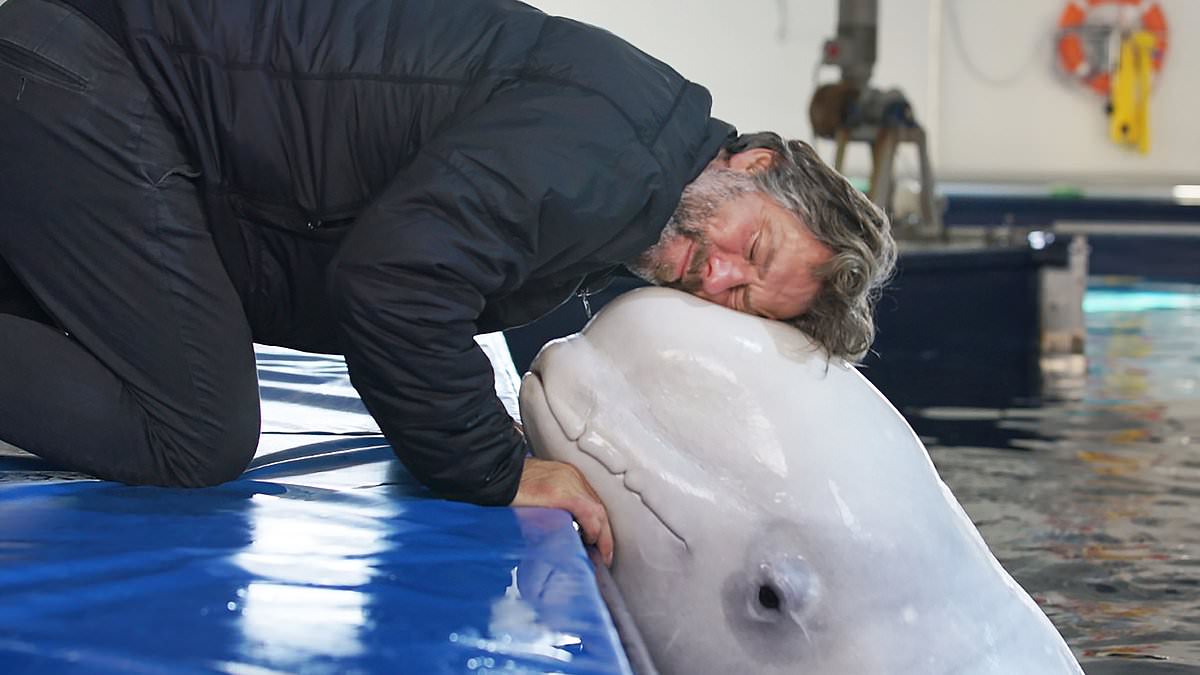The British ‘Seaworld scandal’: ‘Rescued’ Beluga whales that captivated nation’s hearts in John Bishop TV show are still confined to tiny pools years later
By Aidan Radnedge,Editor
Copyright dailymail

Two beluga whales who captured UK viewers’ hearts in a series fronted by wildlife-loving comic John Bishop remain confined to a tiny pool six years after their rescue.
The duo dubbed Little Grey and Little White were transported 6,000 miles from a Chinese zoo to Iceland with the help of a British charity in a much-publicised mission celebrated in 2019 ITV programme John Bishop’s Great Whale Rescue.
Supporters were promised they would enjoy the freedom of an unprecedented ‘sea sanctuary at Klettsvik Bay, off the south coast of Iceland, amid picturesque scenery while no longer made to perform for audiences as they were in Shanghai.
Yet they have spent just 71 days of the past six years out in the open and are currently back in an indoor pool not much bigger than one for humans.
They are still on display, at the Beluga Whale Sanctuary – operated by the UK-based Sea Life Trust and backed by multinational leisure firm Merlin Entertainments.
Visitors to the attraction are charged at least £16 for visits, or £33 for guided tours.
Merlin’s UK attractions include Madame Tussauds, Staffordshire theme park Alton Towers and a series of Sea Life Centres, though these have faced concerns over animal welfare within their enclosures.
Entirely separate US firm SeaWorld has seen its reputation dive in recent years, with accusations the marine life in their care are treated like ‘slaves’ – including whales and dolphins putting on shows for audiences. The firm has denied mistreatment.
The ‘world first’ Icelandic sea sanctuary’s pen for Little Grey and Little White covers almost 32,000 sqm and is up to 10m deep, while the quarantine pool in which they currently reside is said to be 15m x 20m and with no access to outside light.
The average UK outdoor swimming pool measures 10m x 5m.
There were plenty of celebrations when Little Grey and Little White were released from captivity in China and allowed to swim in the sea for the first time.
The British-based Sea Life Trust charity painstakingly planned their 6,000-mile journey from the Chinese aquarium where they performed as show animals for fish to what was celebrated as the world’s first open water sanctuary.
This brought the first time the 40ft, one-ton belugas, both female, have been in the sea since being taken from a Russian whale research centre in 2011, the charity said.
For their trip to Iceland, the pair were put in specially-designed slings with custom-made foam matting to cushion their bodies during the complex journey, which involved a lorry, a Boeing 747-400ERF cargo aircraft and a harbour tugboat.
The mission was showcased in an ITV programme broadcast in October 2020, attracting five-star reviews and millions of viewers – many of whom have kept keenly engaging with social media updates about the two belugas.
Yet now there appears a backlash, five years into the project, with former MEP Brian Monteith saying: ‘Sadly, this is not John Bishop’s Great Whale Rescue, but has ended up becoming John Bishop’s Great Whale Scandal.’
Campaigners say that the two whales were kept in the quarantine pool in a building near the sanctuary for more than a year after their initial arrival in iceland in 2019.
They finally made it into the sea in August 2020 but spent just 71 days there before being returned to the inside pool that November – and have stayed there since.
Mr Monteith, an advisor to campaign group PETA Watch, said: ‘Sea sanctuaries sound fantastic in theory, but unfortunately that is all they are, a theory.
‘Even those that are realised are too often based on deeply flawed plans that leave animals like Little Grey and Little White in worse care than before their “rescues”.
‘Genuine animal lovers will be upset by the substandard conditions in which these belugas are living.’
Annual updates provided online by the Beluga Whale Sanctuary have outlined some of the difficulties the pair appear to have endured trying to adapt to new conditions.
A statement to fans and sponsors last year told of how Little Grey needed treatment at the ‘landside care facility’ for treatment after becoming unwell.
The pair had first been returned there in 2020, after struggling to adapt to the new conditions and climate of the sea sanctuary – Little White especially.
The latest update from the Beluga Whale Sanctuary came on July 31, following last year’s statement suggesting the whales could make a sanctuary return in early 2025.
That statement said: ‘Many of our followers will know, we installed the Intermediate Halo Habitat to help the whales adapt to life in the natural surroundings of our sanctuary.
‘We’ve learnt a lot about the structure and have been working hard with engineering experts to make changes and modifications.
‘We are always learning, improving and setting the highest industry standard of care for others to build upon.
‘The adaptations we’ve made and will continue to make this year to the sanctuary, are designed to support the whales’ gradual acclimatisation to the bay environment.
‘We’re upgrading the care area to be even better to allow for our team to treat the whales should they become unwell in the bay rather than needing to bring them back to the landside care facility when they move.
‘The adaptations to the sanctuary are progressing well, but we have taken the careful but right decision to pause Little White and Little Grey’s return to the sanctuary until Spring 2026.
‘Our commitment to this pioneering project remains as strong as ever, and we will always be guided by the needs of Little Grey and Little White, with their wellbeing and safety as our highest priority.
‘Little White and Little Grey are doing well and are healthy in their landside care facility where we’ve continued to carefully monitor their progress.’
But there has been mixed reaction to the updates from people following on Instagram.
One commenter said: ‘I was *so* excited to see them finally in the sea again, and now they been back for over two years with another year of confinement set?’
Another wrote: ‘This whole project just makes me so sad for them… it had good intentions, but I can’t help feel so sorry for them.’
The sanctuary’s Instagram account was also told: ‘This is very disappointing, and it’s casting doubt on the sanctuary concept.’
But there are also supportive responses such as ‘Thank you for taking such good care of these beautiful beings’ and ‘Thank you for putting the needs of the animals first, despite criticism and pushback’.
Merlin Entertainments acquired Changfeng Ocean World aquarium in China in 2012 and then began searching for a new home for the belugas.
The company made a ‘substantial donation’ to the Sea Life Trust to fund the operation.
The trust previously described Little Grey as ‘very playful’ and with a mischievous side, liking to spit water at her care team.
Little White was said to be ‘much more reserved but still likes to play and forms close bonds with her carers’.
Beluga whales have been described as ‘the canary of the sea’, with their high-pitched twitter and ability to produce 11 other types of sound such as cackling and whistling.
They are born dark grey but by the age of five turn bright white and on average live for between 20 to 40 years, reaching lengths up to 18ft and weights of 1,600kg.
Unlike many cetaceans, they can swim backwards – but do not jump out of the water like dolphins or killer whales.
The population of just 150,000 worldwide is spread across the arctic regions of the northern hemisphere – northern Alaska, Canada, Greenland, the north coast of Russia, and the upper regions of Japan and China.
They were one of the first whale species to be kept in captivity – the first captured beluga being recorded in 1861 in Barnum’s Museum, New York.
Since 1973, international whale-hunting laws have sought to control the trade of belugas and now only certain Inuit tribes are permitted to hunt the cetaceans.
However, the International Union for Conservation of Nature listed the species in 2008 as ‘near threatened’.
Graham McGrath, Managing Director at Sea Life Trust, said: ‘We strongly reject the implication that the Beluga Whale Sanctuary project is failing or that there is any commercial motive behind our work – or connected to Merlin Entertainments.
‘We are a standalone charity running the sanctuary. Since its inception, the sanctuary has been driven by a single purpose: to provide the best possible welfare for the belugas and support their transition from a previous performative environment to a world-first open-water sanctuary.
‘As was widely seen in the John Bishop documentary, the whales have previously been out in the bay, experiencing an environment far closer to their natural home than ever before.
‘This is a pioneering project with no existing blueprint and, as with any world-first, it has faced challenges, from severe weather conditions to the global impact of COVID, construction complexities, and temporary health issues for the whales. These have all been managed with the welfare of the animals as our absolute priority.
‘The whales continue to thrive in a vastly improved environment compared to their previous conditions in China. To suggest otherwise misrepresents the progress, the dedication of the teams involved, and the unique significance of this sanctuary.’
Rob Hicks, Vice President for Global Conservation, Welfare and Education at Merlin Entertainments, said: ‘The SEA LIFE TRUST Beluga Whale Sanctuary is an independent and not-for-profit charity, with a dedicated team of animal experts committed to caring and prioritising the welfare of these two amazing beluga whales, Little Grey and Little White.
‘Merlin Entertainments continues to support the sanctuary and has long held the belief that cetaceans, whales and dolphins should not be kept in captivity for frivolous entertainment.
‘While the whales are currently in the landside care facility, their presence is driven by what is best for them at this stage of their journey. We remain fully committed to their gradual acclimatisation to the bay, and we are confident the whales will be ready to move to the sanctuary care pools in Klettsvik Bay in spring 2026.
‘We have seen first-hand the significant effort, cost and sheer amount of care and passion that it takes to create a groundbreaking world-first sanctuary and beyond that, to maintain it. Every decision, every adaptation, and every step forward has been driven by one guiding principle: putting Little Grey and Little White’s welfare above all else.’
The Daily Mail has approached representatives of John Bishop for comment.



